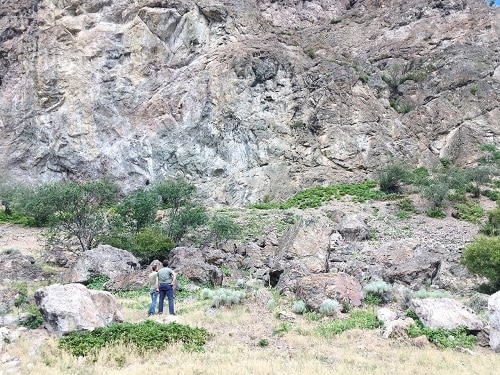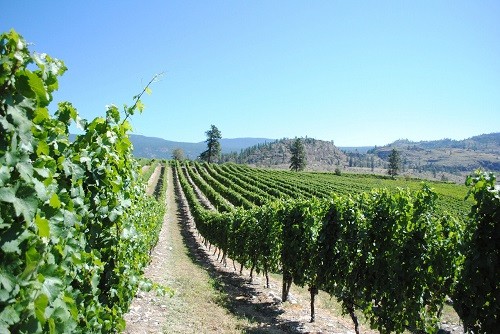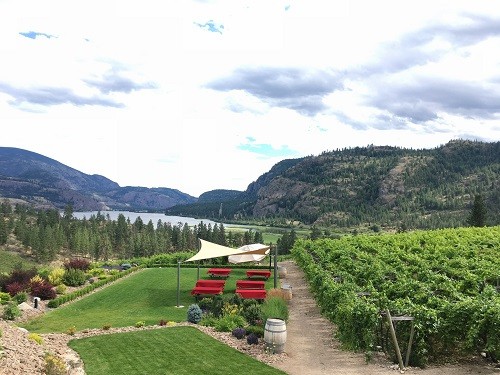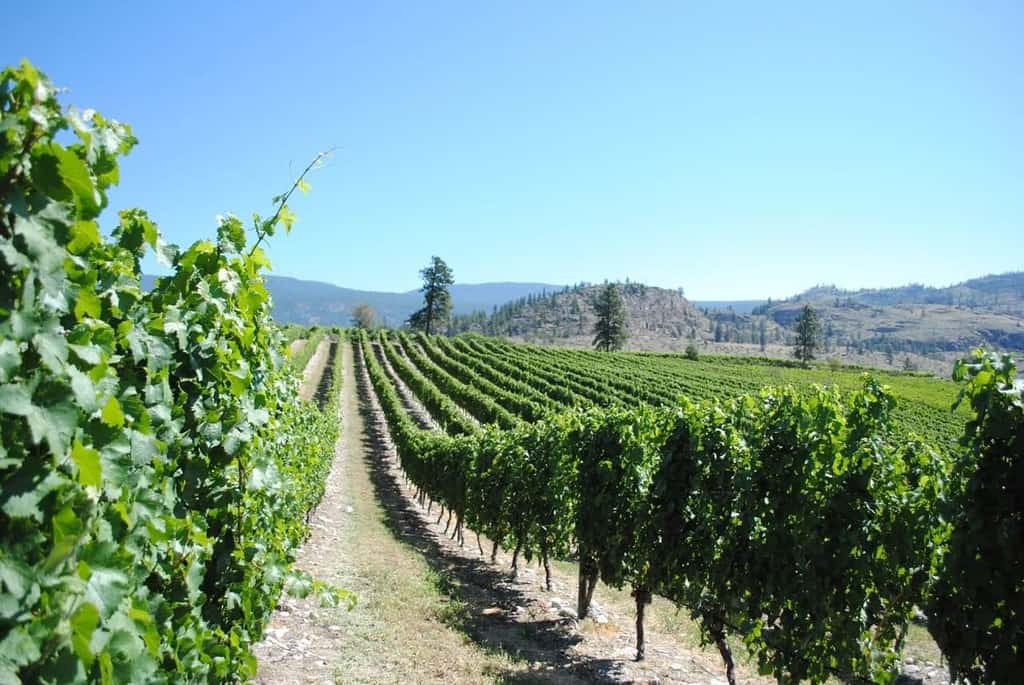Okanagan Falls
With a world of information at our fingertips, finding someplace relatively undiscovered is rare. British Columbia has begun to earn an international reputation as being a hidden gem of a wine region and that, with some irony, is making it an increasingly popular destination. Within its vast geographical borders are smaller pockets even less explored and so it’s fair to say that as a winegrowing area Okanagan Falls still rests somewhere along the spectrum of the unknown. For now, at least.
Located in the Okanagan Valley at the south end of Skaha Lake, the headwaters of what’s now Okanagan Falls was formed eons ago by the discharge of Glacial Lake Penticton. This unincorporated town (population approximately 2,500) is bounded on the west by Mount McLellan and on the east by the ancient volcanic remnants that is Peach Cliff. At 600m/1968ft in height, Peach Cliff dominates the landscape and actually affects weather patterns. Keep that in mind for later.

For centuries Okanagan Falls has been important to the Okanagan First Nations, as it was where band members chose the Salmon Chief. The land is in the territory of the Osoyoos Indian Band and is culturally significant for the Syilx Peoples as a traditional fishing camp, gathering place, and trading site. Today it remains a location for meaningful celebrations like the Okanagan Nation Alliance Salmon Feast each September “to honour the sacredness of the river.” In 2015, the Okanagan Falls provincial park was renamed sx̌ʷəx̌ʷnitkʷ for its traditional Okanagan place name meaning little falls and is managed and operated by the Osoyoos Indian Band. As we explore Okanagan Falls, it’s on First Nations lands we travel.
This small community was once known as Dogtown, as Skaha in the Okanagan language means dog. Okanagan Falls was established in 1876 and commercial orchards took root in the late 1880s as irrigation became more readily available, but it wasn’t until the 1970s that the first vineyards were planted by the founders of Blue Mountain Winery. They’re now recognized as regional specialists in traditional method sparkling wine production (again, take note). A flood control dam replaced the original falls in the 1950s, regulating water volume as it flows south through the Okanagan River and eventually emptying into Washington State. Briefly, the area had a small flirtation with mining (silver, gold, copper, and zinc) but that ended almost as quickly as it started.
In 2018, the provincial government recognized Okanagan Falls as the second official sub-gi (sub-region) for the Okanagan Valley. Its unique topographies include the glaciofluvial landforms along Oliver Ranch Road and surrounding areas: north from Shuttleworth Creek to the south end of Oliver Ranch Road where it meets Vaseux Lake. It’s a long, narrow stretch that offers geological proof of what growers on the land have known since day one: there’s something special here.
This newly defined growing region is comprised of alluvial floodplains, glaciofluvial deposits, till-like sediment, loamy and gravelly sand, and clay. What also helps to set this area apart is a series of ‘kettles’, distinct depressions in the land formed (speculatively) by ice calving off a receding glacier. The theory holds that as the ice melts, these deep depressions or holes are left behind. The Okanagan Falls sub-gi covers a total of 800 hectares, 150 of which are planted with vineyard, and is home to nine wineries.
As seen on a map it might not look like there’s much ground to cover when exploring the area and its wineries, but looks can be deceiving. Be sure to plan enough time to meander, get a little lost, and find your way again. The best adventures are often those we least plan for.
Getting to Okanagan Falls
Okanagan Falls is in the southern Okanagan Valley of British Columbia and accessible by major highways connecting to Route 97 (extending through Washington state). It’s an adventurous drive or quick flight from major centers like Seattle, Spokane, Vancouver, and Calgary. International flights arrive in Kelowna and domestic flights can touch down directly in nearby Penticton. If you travel by road, check provincial resources like DriveBC.com for traffic updates.
- From Seattle: 307mi
- From Spokane: 212mi
- From Vancouver: 240mi
- From Calgary: 428mi

Wineries To VISIT
- One of the first farm-gate licenses in the province, Wild Goose Winery is synonymous with bright white wines like Riesling (Stony Slope of Mystic River series), Pinot Blanc (they arguably wrote the book on it in BC), Gewurztraminer, and Pinot Gris – remember to try the Meritage, because YUM.
- Stag’s Hollow Winery for the largest selection of small lot production wines. Try the Renaissance series (Grenache, yes) and geek out over cool things like Dolcetto, Tempranillo, Albariño, Muscat Frizzante (so pretty), or Blanc de Noirs.
- Synchromesh Wines by appointment (if you’re lucky) for one of several vineyard-specific Rieslings, an off-the-beaten-path Rosé, Pinot Noir, and the hello Tertre Rouge named after the famous race track corner. Their Stormhaven Vineyard is quite literally that, protected from storm extremes by the monster rock formation that is Peach Cliff.
- Liquidity Wines focuses on Chardonnay and Pinot Noir and has several stellar smaller production wines in the portfolio, with a new addition of traditional method bubbles for this season. Did I mention the Viognier? Viognier.
- Meyer Family Vineyards also delves into Chardonnay and Pinot Noir (notice a theme?) with several of each on offer, plus delightful traditional method bubbles and seriously good Rosé.
- Pop in to Blue Mountain Winery for the many kinds of bubbles (NV brut or vintage), Chardonnay, Pinot Noir, or Gamay Noir.

Where to EAT
- Have lunch or dinner at Liquidity Wines Bistro – dine indoors for an art gallery feel, or venture onto the patio and sip beside the infinity pool.
- Enjoy a smoked meat feast at the Smoke and Oak Bistro at Wild Goose Winery while overlooking some of the oldest vines in the region. Remember to grab a bottle of that Meritage or a savory Rosé.
- Linger over a picnic at Noble Ridge Vineyards, surrounded by vineyards and unparalleled views.
- Tuck in to some ice cream at Tickleberry’s where they’ve been tempting visitors with treats since the late 1980s. It’s right on the highway and easily identified by the minor traffic jam it causes – but it is so worth the effort.
Where to STAY
- At a local B&B like the popular God’s Mountain, where rooms are booked year after year by returning guests and the breakfast is legendary. Even if you’re not staying here, check their website for one of the long table Sunday night dinners and snag a seat if you can.
- In the campground at sx̌ʷəx̌ʷnitkʷ provincial park and listen to the water as it lulls you to sleep.
- There isn’t hotel/motel lodging in Okanagan Falls proper, but Penticton is a quick 20 minutes north and Oliver is equidistant to the south. Tack on a few days to your trip and see more of the surrounding area. There’s more wine to be had.
- See a list of some of the trending hotels in Penticton and hotel options in Oliver.
More Ways To Explore Canada
Canadian Wine Festivals and Events For 2019
Exploring British Columbia Wine Country: What To Drink, Where To Eat, Where To Stay
How To Spend Time in Ontario Wine Country
3 Day Itinerary For Visiting Kelowna Wine Country
Similkameen Valley Itinerary – Explore Wineries, Restaurants and Hotels
Oliver & Osoyoos Wine Country: Best Wineries, Restaurants & Hotels
